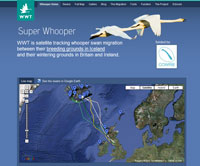Whooper swan Y6K ignores volcanic ash flight restrictions and makes it safely to Iceland
It is a truly remarkable story to tell.
While air travel across large parts of Europe came to a
complete standstill as a result of the volcanic eruption
in Iceland on 14 April 2010, a single satellite tagged Whooper
swan (Cygnus cygnus) made headlines as it braved
the volcanic ash cloud and made it safely to its breeding
grounds in Iceland.
 Background
Background
to the story is the Whooper swan satellite-tracking project,
being conducted by the Wildfowl & Wetlands Trust (WWT),
which aims to describe the migration routes and flight heights
of Whooper swans in relation to offshore wind farm sites.
The major eruption of the volcano under the Eyjafjallajokull
glacier not only brought air traffic in Europe to a halt,
but also caused worries for the well-being of migrating
Whooper swans and other waterbirds on their way to their
Icelandic breeding grounds.
Concerns increased when it became clear
that a single satellite tagged swan (Y6K) being tracked
in the framework of the project had chosen to migrate at
just the wrong time. Having originally migrated direct from
Iceland to Ireland last autumn, he moved via Kintyre to
the area around the Solway in mid-winter. On 12 April he
started heading north from Dumfriesshire and had reached
the Outer Hebrides by the morning of 13 April. That evening
he set off for Iceland and by early the following evening
he was more than half-way across. After spending the night
on the water he made much slower headway on the morning
of 15 April and seemed to be veering a little off course
before turning and heading northwesterly again towards Iceland.
The southeasterly winds pushing the ash cloud towards Britain
meant that Y6K was effectively flying into head winds, which
may well explain why it took him 4.5 days to cross from
the Outer Hebrides to Iceland. But he finally came in over
east Iceland at mid-day on 17 April and spent the next 24
hours resting in fields near Höfn. It is of course
difficult to determine the extent to which he changed direction
to avoid coming in near the volcano; he should certainly
have been able to see the plume whilst still out at sea.
In the end, swan Y6K safely arrived in
Iceland, although concerns regarding the well-being of Icelandic-breeding
goose and swan populations over the coming months remain.
Because the vast majority of migratory birds fly at altitudes
of 7,000 meters or less where the ash cloud is drifting
around, there is no doubt that they are also being exposed
to the ash. Since birds are more sensitive than humans to
airborne toxins and lung dysfunction, it is most likely
that many birds are being negatively impacted. According
to a report from Dr Olafur Einarsson from the Icelandic
Institute of Natural History in Reykjavik and a colleague
from WWT, bird deaths have occurred during previous eruptions
of other volcanoes in Iceland, when the feeding areas were
covered with ash, causing major problems for farmers and
birds. Fortunately at the moment the main area affected,
between Vik (in the west) and Kirkjubaejarklaustur (in the
east), is primarily an area of sand and gravel, leaving
internationally important whooper swan staging or breeding
sites still suitable for swans. Nevertheless, WWT and Icelandic
colleagues will continue to monitor any impact on the swan
and goose populations breeding in Iceland this summer, both
during the summer months and following their migration to
Britain and Ireland next autumn.
Further Information:
For more information on the Whooper swan
story and the satellite-tracking project being carried out
by the Wildfowl & Wetlands Trust (WWT) see the following
links:
- http://www.wwt.org.uk/whooper
- http://www.wwt.org.uk/latest-news/fears-for-whooper-swan-as-it-disappears-into-volcanic-cloud
- http://www.wildlifeextra.com/go/news/whooper-iceland.html#cr
- http://scienceblogs.com/grrlscientist/2010/04/how_are_birds_affected_by_volc.php
- http://www.surfbirds.com/sbirdsnews/archives/2010/04/fears_for_whoop.html
Last updated on 16 June 2014


